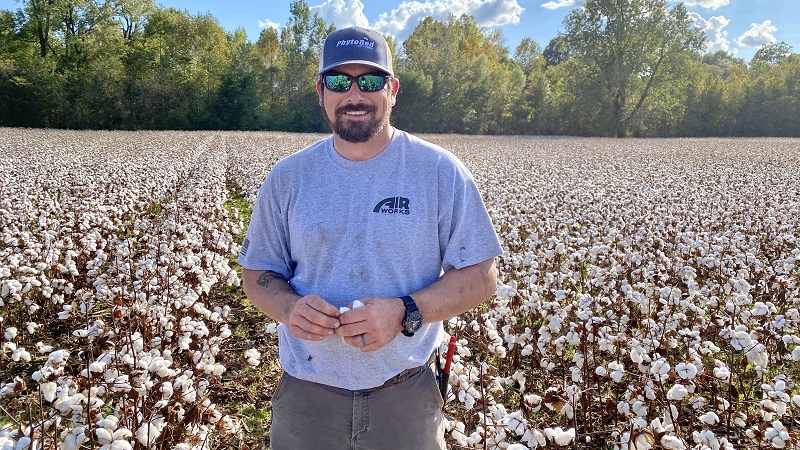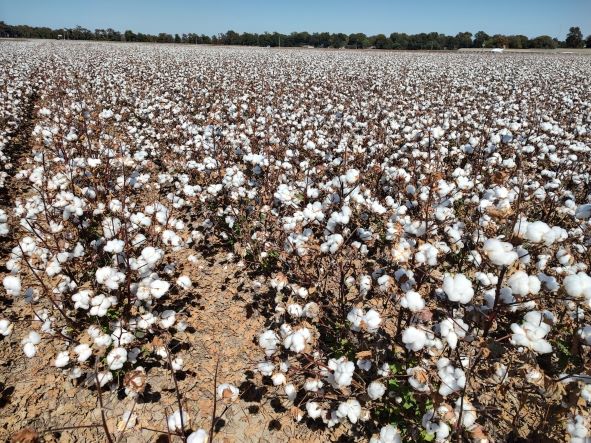Crop Scan Ag Report: Rain Is the Word of the Week
It’s raining across many parts of the Cotton Belt – in some case, too much for planters to make significant progress. In other areas, cotton is already up to a stand. And in West Texas, growers are moving quickly to take advantage of recent rains.
Here’s what our contributing consultants had to report for mid-May.
Chad Harrell owns and operates Harrell Agronomic Services in Northeastern North Carolina.
We have made good progress over the past two weeks. I would say about 75% of our cotton acres have been planted. We had some cooler wet weather over the past week that caused us to lose 4 or 5 days of planting. Many growers have finished, while others should finish this week as a few wet fields dry out.
The earliest planted cotton has received a thrips application and is now at the 3rd leaf stage. We will have more insecticide and herbicide applications going out this week.
Wes Briggs consults on cotton, corn, peanuts, soybeans, and small grains for growers in Georgia, Alabama, and Florida.
It’s not raining at the moment, which is a good thing. In our last rain event on Friday and Saturday, we got from 1½ inches up to 3 inches in places. We were already wet and had just gotten a few planters back into the fields on Thursday on some sandy soil – probably too wet to be planting. We are now soaking wet. We’ve been out of the field for two of our prime planting weeks for cotton and peanuts. I don’t remember ever being out for two weeks in May and couldn’t plant. We’ve also lost some stands to wind on Mother’s Day. There’s a lot of water standing in fields right now, but we may get some planters going again by the end of this week on some sand.
My growers are probably about 75% planted on peanuts, but only 25% planted on cotton. Our oldest cotton ranges from emerging to 5 leaves. We’re probably going to have to replant about 300-400 acres of cotton that we know of. We’re going to finish planting what needs to be planted and worry about replants on the tail end. We need some sunshine to dry things out.
Overall, cotton that is up looks pretty good. It’s a little ragged from the wind and rain. We are seeing some thrips pressure, and when can get back in the field, we’ll be spraying for thrips and weeds and fertilizing – just normal farm practices to try to get our feet back under us. We’re also seeing some Rhizoctonia in some strip till fields.
We have a long way to go on cotton. I hope it’ll dry out so we can get our acres in.
Tucker Miller is a Mississippi-based independent private consultant for cotton, soybeans, corn, peanuts, rice, and vegetables.
We finished planting cotton this past week. Our cotton ranges from 5th true leaf to just coming up. Thrips pressure has been low on the early planting, but we are now seeing some pressure from thrips on the newly emerged plants.
 Photo: Tucker Miller
Photo: Tucker Miller
We have started weed control measures in the cotton, using Liberty and Select on a lot of acres to save our one shot of dicamba for later.
Corn is really growing now. It is laid by, and we are laying out poly pipe now. Irrigation will commence this week if it doesn’t rain.
Most soybeans are laid by and sprayed with herbicides. We’re using a lot of Liberty and Roundup on the Liberty beans due to the shortage of dicamba. Our older beans are at seven and eight nodes. There’s very little insect pressure at this time .
Looks like we are off to a good start.
Mark Nemec is an independent agricultural consultant for cotton, wheat, grain sorghum and corn in the Blacklands and Brazos River Bottom area of Central Texas.
It has been a rough couple of weeks in Central Texas. More rain has fallen here, preventing any field work. Some areas have already received their annual rainfall, and it’s only middle of May. The last few rains have been heavy with amounts ranging from 2-8 inches. This has made the creeks and rivers backup into ditches and low areas of fields.
The Blacklands area still hasn’t been able to plant very much. The Brazos Bottom was able to get most of the cotton planted. There are some fields that need to be replanted if it dries out. The only problem is another rain event forecast for Central Texas this week.
The cotton has been struggling with too much moisture and not enough sun, as well as pretty high thrips pressure. The sun has actually been out for a couple of days, and the cotton has responded quite nicely. Some of the earliest plants on high ground are reaching pinhead square.
Weeds are definitely a problem in many fields. The last month and a half has been too wet to get a sprayer in the cotton patches. Pre-emerge and burndown herbicides have played out by now. The weeds are big, thick, and mean now. We are going to have our hands full trying to get them under control.
Kerry Siders is Texas A&M AgriLife Extension Agent-IPM for Hockley, Cochran, and Lamb Counties.
The Texas High Plains has, in the past week, finally received some general rains, with 1” or better being measured. For my area around Levelland to the New Mexico state line, this is the first good measurable rain since the first of the year.
There has been some planting of pivot irrigated land over the last 10 days or so, but with rain and rising temperatures, most all irrigated acres will now be planted and then dryland acres. We are seeing a slight uptick in the use of Enlist technology from PhytoGen, most likely due to the Xtend technology scare a few months ago. Right now, the Xtend situation has settled for this growing season. It is good to have all these tools available.
With the recent rains we’ll need to watch for increasing weed pressure and even insect pests which weeds will host initially. Fortunately, I am not picking up much activity in terms of thrips or other foliar feeding insects currently. I am concerned about wireworms, especially where we have had wheat cover or a previous grass crop.
If you need help scouting or with other issues which you will deal with in the production of cotton, I would highly recommend you hire a professional crop consultant.














